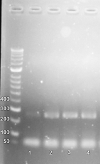A POTENTIAL ZOONOTIC PARASITE: CRYPTOSPORIDIUM PARVUM TRANSMISSION IN RATS, PIGS AND HUMANS IN WEST LOMBOK, INDONESIA
- PMID: 33889802
- PMCID: PMC8052970
- DOI: 10.21010/ajid.v15i2.8
A POTENTIAL ZOONOTIC PARASITE: CRYPTOSPORIDIUM PARVUM TRANSMISSION IN RATS, PIGS AND HUMANS IN WEST LOMBOK, INDONESIA
Abstract
Background: Cryptosporidium is a neglected zoonotic disease, but with the expansion of the human community into the animal environment, its incidence is increasing. Animals such as rats and pigs can act as intermediate hosts and transmit Cryptosporidium to humans due to their proximity. Transmission occurs due to the ability of Cryptosporidium to survive in any new host. The research aimed to identify and describe the transmission of Cryptosporidium from animals to humans.
Materials and methods: This research was a cross sectional study and samples were collected from 84 rats caught in residential areas, 205 pigs, and 438 humans in West Lombok. Fecal samples were examined using polymerase chain reaction (PCR) and sequencing to isolate the presence of Cryptosporidium, and identify the genetic similarity of the parasites found in rats and pigs with those that infect humans.
Results: The PCR results found Cryptosporidium parvum in 4.76% (4/84) in rats; 6.34% 13/205) in pigs; and 0.91% (4/438) in humans. The sequencing results showed genetic kinship of C. parvum in rats, pigs, and humans. Based on sequence confirmation from Gene Banks and edited using ClustalW with MEGA X software, there are genetic similarities between Cryptosporidium isolates from West Lombok and C. suis isolates of cattle from Uganda and C. suis isolates of pigs from Slovakia.
Conclusion: There are genetic similarities of Cryptosporidium in animals and humans, requiring that the Public Health programs in those contaminated areas must receive priority attention to prevent further transmission of these potentially fatal parasites.
Keywords: Cryptosporidium; Pigs and Humans; Rats; Zoonotic parasite.
Copyright: © 2021 Afr. J. Infect. Diseases.
Conflict of interest statement
Conflict of Interest: The authors declare that they have no conflict of interest.
Figures



Similar articles
-
Detection and molecular characterisation of Cryptosporidium spp. in Swedish pigs.Acta Vet Scand. 2020 Jul 29;62(1):40. doi: 10.1186/s13028-020-00537-z. Acta Vet Scand. 2020. PMID: 32727527 Free PMC article.
-
Molecular characterization of Cryptosporidium isolates from diarrheal dairy calves in France.Vet Parasitol Reg Stud Reports. 2019 Dec;18:100323. doi: 10.1016/j.vprsr.2019.100323. Epub 2019 Jul 24. Vet Parasitol Reg Stud Reports. 2019. PMID: 31796198 Free PMC article.
-
First microscopic and molecular identification of Cryptosporidium spp. in fat sand rats (Psammomys obesus) in Egypt and their potential zoonotic implications.Front Vet Sci. 2025 Jan 23;11:1488508. doi: 10.3389/fvets.2024.1488508. eCollection 2024. Front Vet Sci. 2025. PMID: 39916967 Free PMC article.
-
Rodents as a reservoir of infection caused by multiple zoonotic species/genotypes of C. parvum, C. hominis, C. suis, C. scrofarum, and the first evidence of C. muskrat genotypes I and II of rodents in Europe.Acta Trop. 2017 Aug;172:29-35. doi: 10.1016/j.actatropica.2017.04.013. Epub 2017 Apr 20. Acta Trop. 2017. PMID: 28433573 Review.
-
[New methods for the diagnosis of Cryptosporidium and Giardia].Parassitologia. 2004 Jun;46(1-2):151-5. Parassitologia. 2004. PMID: 15305706 Review. Italian.
Cited by
-
Emerging zoonotic diseases in Southeast Asia in the period 2011-2022: a systematic literature review.Vet Q. 2024 Dec;44(1):1-15. doi: 10.1080/01652176.2023.2300965. Epub 2024 Jan 16. Vet Q. 2024. PMID: 38229485 Free PMC article.
-
Global prevalence of Cryptosporidium spp. in pigs: a systematic review and meta-analysis.Parasitology. 2023 May;150(6):531-544. doi: 10.1017/S0031182023000276. Epub 2023 Mar 20. Parasitology. 2023. PMID: 37051887 Free PMC article.
References
-
- Azzam K.M, El-Abd N.M, El-Hady A, Eman A. Survey of Endoparasites of Different Rodent Species in Egypt. Egyptian Journal of Biological Pest Control. 2016;26:4.
-
- Badry A.H.H, Jameel A.Y, Mero W.M.S. Pathogenic microorganisms associated with diarrhea in infants and children in Duhok province, Kurdistan region/Iraq. Journal of University of Zakho. 2014;2(2):266–275.
LinkOut - more resources
Full Text Sources
Other Literature Sources
